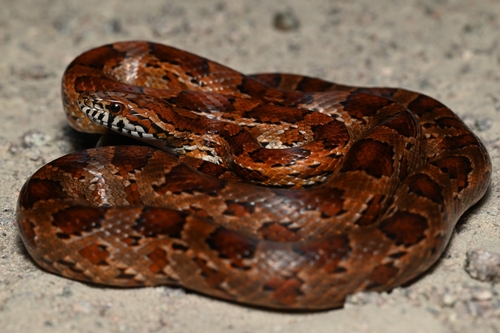
Corn Snake
The corn snake, Pantherophis guttatus, captivates with its vivid red-orange scales and black-bordered blotches. This agile climber is crucial in managing rodent populations. Found in North America's fields and forests, it enriches ecosystems while showcasing nature's colorful artistry.
20 years
Lifespan
453.59237 - 907.18474 g
Weight
Length: 61 - 183 cm
Size
Yellow, Red, White, Orange
Color
Low
Aggression
Least Concern
Conservation Status
Stable
Population Trend
Characteristics
Commonly known as the corn snake, Pantherophis guttatus is a non-venomous snake native to North America. It thrives in overgrown fields, forests, and abandoned buildings. Distinguished by its vibrant red-orange scales with black-bordered blotches, it is known for its excellent climbing ability and plays a vital role in controlling rodent populations.
Distribution Range of the Corn Snake
Pantherophis guttatus, commonly known as the corn snake, is native to the southeastern United States. Its geographical distribution includes states such as Florida, Georgia, South Carolina, North Carolina, Alabama, and parts of Louisiana, Mississippi, and Kentucky. It can also be found in Texas and southern Virginia.
Corn Snake's Habitat
Environmental Conditions
Corn snakes typically inhabit warm, temperate areas. They are often found in overgrown fields, forest edges, groves, and farmlands. The species thrives in environments where there is ample cover and a supply of rodents, their primary prey.
Ecological Niche
Corn snakes play an important role in controlling rodent populations within their habitats. They are well-adapted to living in both terrestrial and arboreal environments, often seeking shelter in burrows, under logs, or within abandoned buildings. The species is known for its adaptability to a range of environments, from dry grasslands to humid forests.
Copyright @ Nature Style Limited. All Rights Reserved.
 English
English